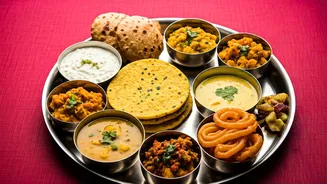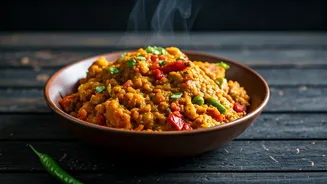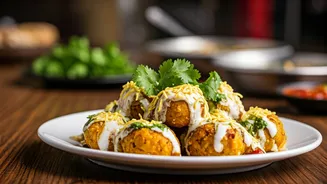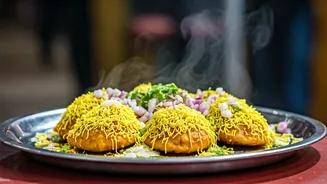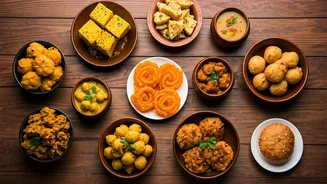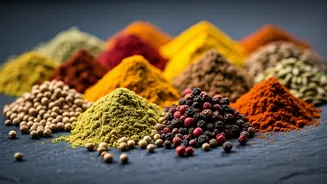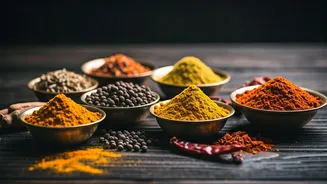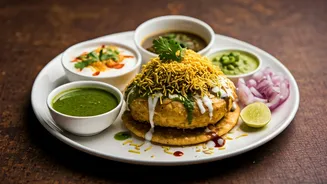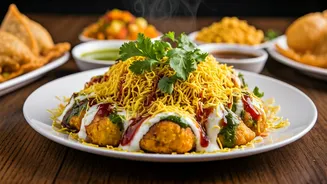Dhokla: The Starter King
Dhokla, a beloved Gujarati snack, holds a special place in the hearts of food lovers. Made from fermented batter, typically a mix of rice and chickpeas,
dhokla boasts a light, fluffy texture. Steaming the batter gives it its airy form, followed by a tempering of mustard seeds, green chilies, and curry leaves in hot oil. This process enhances the flavor and adds a delightful crunch. Often served with a sweet and tangy chutney, dhokla is a perfect example of Gujarati cuisine's ability to create contrasting yet harmonious flavors. Its versatility makes it suitable as a breakfast item, a snack, or even a light meal. The fermentation process itself contributes to the distinctive flavor profile that makes dhokla so irresistible. The garnish, usually coriander leaves and sometimes grated coconut, contributes to the overall visual appeal and taste of this classic snack.
Undhiyu: A Winter Warmer
Undhiyu, a winter delicacy, is a medley of vegetables cooked upside down in earthen pots. The unique cooking method, involving slow cooking underground or in a closed vessel, infuses the dish with smoky flavors. The mixture typically includes a variety of seasonal vegetables like eggplant, potatoes, beans, and root vegetables, seasoned with a blend of spices and herbs. The earthy fragrance of undhiyu and its complex taste profile make it a cherished dish, particularly during the winter months. Undhiyu is more than just a dish; it's a social experience, often prepared and enjoyed communally. Preparing undhiyu requires significant time and effort, contributing to its status as a celebratory dish. The vegetables absorb the flavors of the spices and the earthen pot, resulting in a rich and satisfying culinary experience.
Thepla: A Traveling Treat
Thepla, a flatbread, is a staple in Gujarati households, perfect for travel or a quick meal. Made from wheat flour, spices, and sometimes fenugreek leaves (methi), thepla offers a subtle aromatic flavor and texture. It's often accompanied by yogurt, pickles, or chutney. Thepla’s practicality stems from its longevity; it remains fresh for several days, making it ideal for journeys. The preparation varies slightly, with families adding their preferred spices and herbs, and often includes the use of oil or ghee during the cooking process. Whether packed for a picnic or enjoyed at home, thepla represents comfort food at its finest, a blend of flavors, and nutritional value. The various ingredients used, such as turmeric, chilies, and other spices, contribute both to the taste and the visual appeal of this simple yet delightful dish.
Khandvi: Delicate Rolls
Khandvi, a popular snack, represents the finesse and skill in Gujarati cooking. It comprises delicate rolls made from a batter of gram flour (besan) and buttermilk, spiced with ginger, green chilies, and other seasonings. The batter is cooked to a thick consistency and spread thinly. Once set, it is rolled up into spirals. The final step involves a tempering of mustard seeds and sesame seeds, which enhances both the flavor and appearance. Khandvi offers a blend of textures, from the smooth rolls to the crunchy tempering. It is frequently presented as a light and flavorful snack or appetizer. The precise cooking and rolling techniques are crucial to create the perfect texture and appearance of Khandvi, often showcasing culinary expertise. Its visual appeal and balanced flavors contribute to its wide popularity.
Dhokli: Savory Dumplings
Dhokli, a dish incorporating flour dumplings, highlights the creativity in Gujarati cuisine. The dumplings are typically made from wheat flour and spices, cooked in a flavorful lentil-based gravy, often made with toor dal. The spices add a complex depth of flavor to the otherwise simple ingredients. The combination of the soft dumplings and the savory gravy offers a comforting and satisfying meal. Different variations of dhokli exist; some versions are dry, while others have a thicker gravy. The simplicity of this dish, combined with its satisfying taste, makes it a favorite in many Gujarati homes. It is a hearty meal that is perfect for any time of the day and exemplifies how basic ingredients can create something delicious and fulfilling. Often, the dish is garnished with fresh coriander leaves, which give the food a fresh scent.
Handvo: Savory Cake
Handvo, a savory cake, is a complete meal on its own. Made with a mix of lentils and vegetables, handvo is baked until golden brown. The batter incorporates a variety of vegetables like bottle gourd, carrots, and spinach, along with spices, which creates a blend of flavors and textures. The baking process gives it a crispy exterior and a soft, moist interior. Handvo is frequently served with a green chutney or yogurt, adding extra dimensions of flavor. It's often enjoyed as a snack or a light meal. The fermentation of the batter adds a slightly tangy flavor to the cake, while the mixture of spices adds complexity. The texture and presentation, with its golden-brown crust and vibrant vegetables, make it visually appealing.
Khaman: Another Steamed Treat
Khaman, another steamed snack, resembles dhokla in its fluffy texture but is typically made with chana dal (split chickpeas). The fermentation process is key to the texture and taste. After steaming, it is tempered with mustard seeds, green chilies, and curry leaves to enhance the taste. Khaman is often served with sev (thin, crispy noodles) and garnished with coriander leaves. It is a popular street food and is also enjoyed at home. The preparation involves a careful balance of ingredients and precise steaming to ensure a soft and airy texture. The blend of sweet, sour, and spicy flavors, combined with the soft texture, provides a delightful taste that makes it an everyday favorite. The use of various spices in tempering gives it a distinct aroma.
Gujarati Kadhi: A Staple
Gujarati Kadhi, a yogurt-based curry, is a comforting and flavorful staple in Gujarati cuisine. Made from a combination of yogurt, gram flour, and spices, Gujarati kadhi usually has a thin consistency, offering a tangy and mildly spiced flavor. The addition of sugar or jaggery provides a subtle sweetness, balancing the other flavors. The tadka or tempering, often including mustard seeds, curry leaves, and asafoetida, provides an aromatic boost. It is commonly served with rice and is a wholesome meal, perfect for a family dinner. The simplicity of ingredients belies the complexity of the taste, making it an easy-to-prepare and yet highly satisfying dish. This recipe has a variety of different recipes that families make.
Basundi: Sweet Delight
Basundi, a dessert, is a sweet treat made from thickened milk, often flavored with cardamom, nuts, and saffron. The milk is simmered until it reduces and thickens, developing a rich and creamy texture. The addition of sugar, cardamom, and nuts enhances the flavor. Basundi is often served chilled, making it a refreshing dessert. Its thick, creamy texture and sweet taste make it a crowd-pleaser. It is often enjoyed during festivals and special occasions. The slow simmering process ensures a rich and concentrated flavor. The garnishing of nuts and saffron gives an attractive appearance and adds to the flavor profile. This dessert is a great way to end a Gujarati meal.
